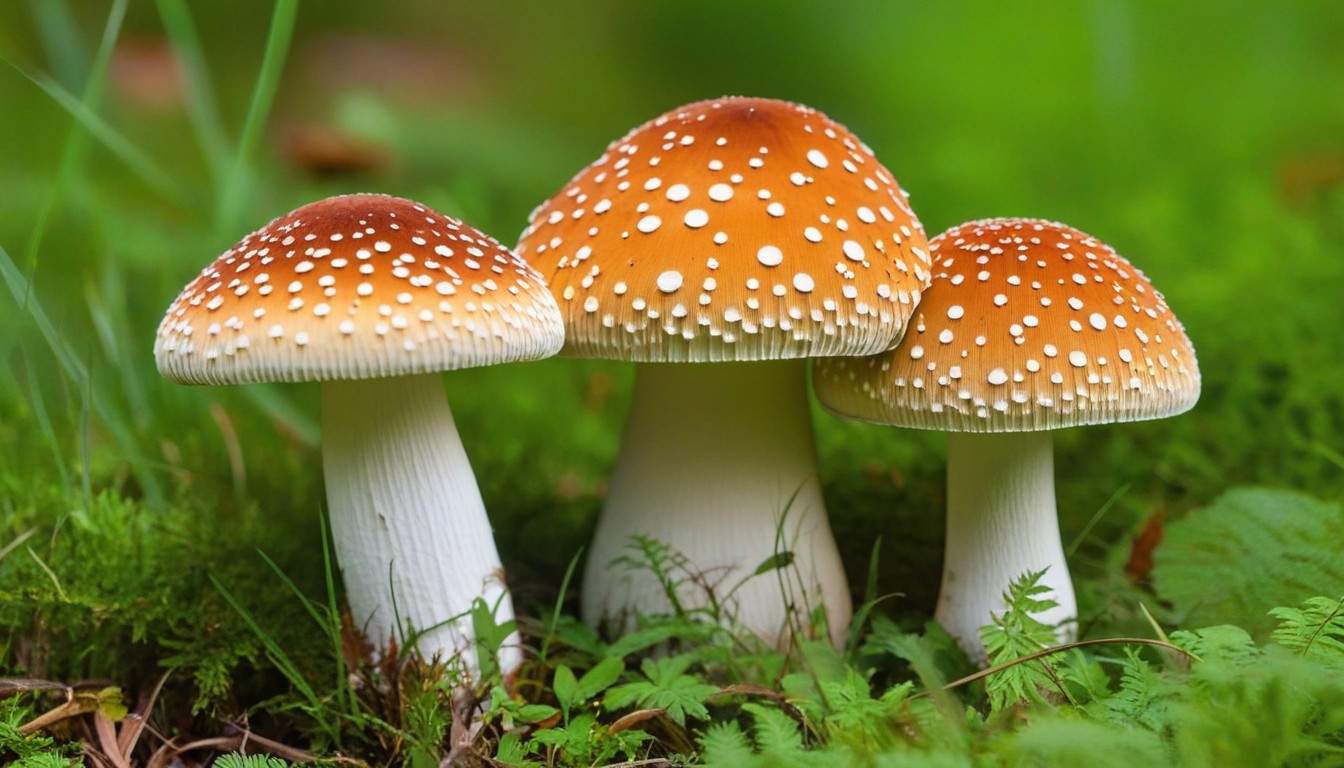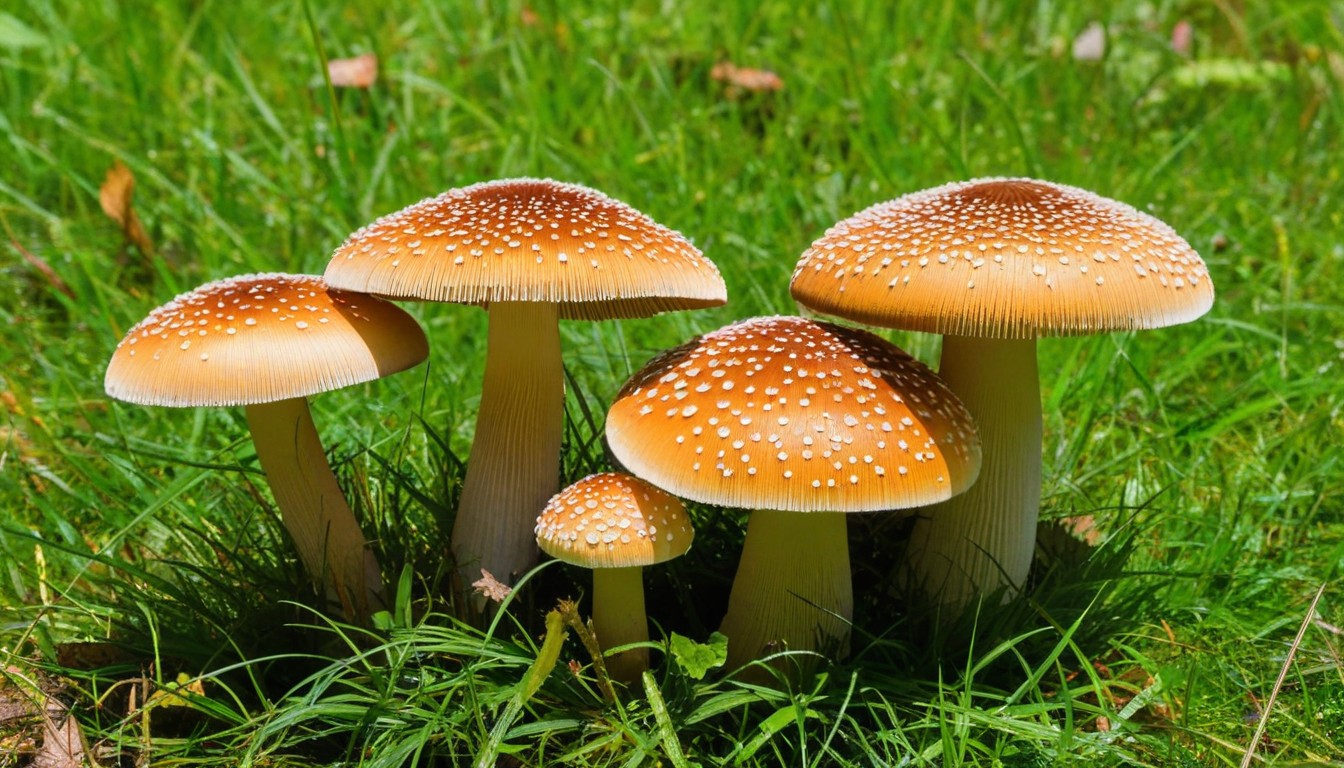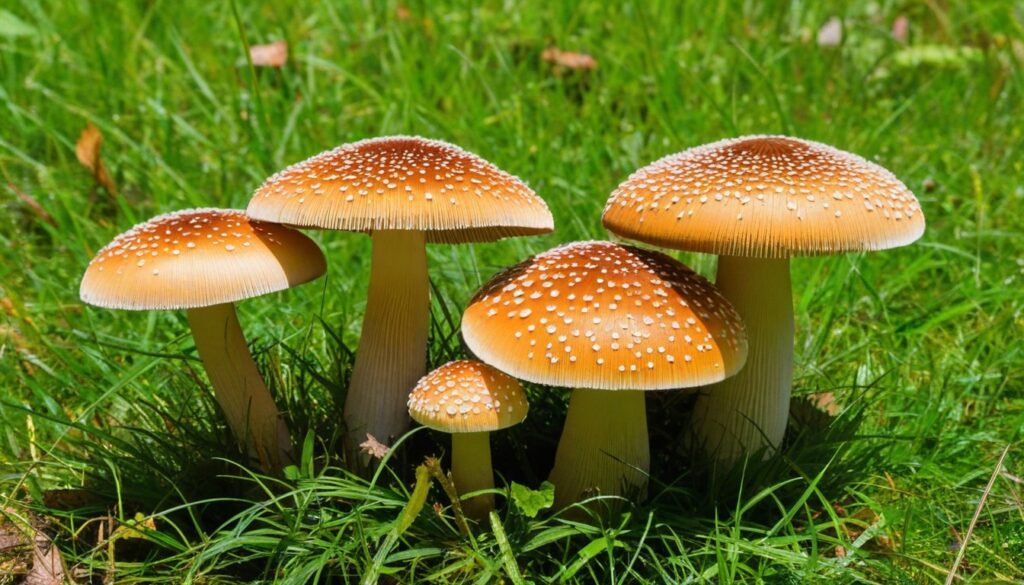If you’re a lawn owner in Georgia, you may have noticed mysterious mushrooms popping up on your turf. While some of these fungi are harmless, others can be detrimental to the health and appearance of your lawn. Identifying and managing lawn mushrooms is crucial to ensure a vibrant and healthy garden. In this comprehensive guide, we will take you on a fascinating journey into the world of lawn mushrooms in Georgia. You will learn how to identify these curious visitors and discover effective ways to manage them safely.
Key Takeaways
- Understanding the characteristics of lawn mushrooms is crucial for proper identification.
- Georgia is home to a variety of lawn mushroom species, with varying impacts on your turf.
- Environmental conditions and soil composition are key factors in mushroom growth.
- Assessing the impact of mushroom infestations on your lawn is important in determining appropriate action.
- Safe removal techniques and natural management methods can be effective in controlling mushroom population.
Understanding Lawn Mushrooms
If you’re a lawn owner in Georgia, chances are you’ve encountered mushrooms in your yard. However, not all fungi are created equal, and it’s important to differentiate lawn mushrooms from other types of mushrooms. But what exactly are lawn mushrooms, and how do you identify them?
Lawn mushrooms are fungi that grow in grassy areas, including lawns, meadows, and pastures. They typically appear as small, dome-shaped caps with a stem, ranging in color from white to brown to red.
One key feature of lawn mushrooms is their gills, which are located on the underside of the caps. These gills produce spores, allowing the mushrooms to reproduce and spread. Another distinctive characteristic is their quick growth rate, with some species appearing overnight.
To properly identify lawn mushrooms, it’s important to pay attention to their physical features, including cap shape and color, gill size and color, and stem height and thickness.
Identifying Lawn Mushrooms
Here are some tips for identifying lawn mushrooms:
- Observe the cap shape and color. Lawn mushrooms typically have small, round caps that range in color from white to brown to red.
- Check the gills. Look underneath the cap to see if there are thin, radiating gills. The color of the gills can range from white to brown to black.
- Measure the stem. The stem height and thickness can vary, with some mushrooms having a short, stubby stem and others having a long, slender stem.
- Look for a spore print. To further confirm the identification of a lawn mushroom, you can create a spore print by placing the cap gills-down on a piece of paper overnight. The color of the spores can provide additional clues for identification.
By properly identifying lawn mushrooms, you can make informed decisions about how to manage them effectively.
Fun fact: Did you know that not all mushrooms have gills? Some species, such as puffballs and morels, have entirely different structures for producing spores.
Common Lawn Mushroom Species in Georgia

As mentioned earlier, Georgia is home to numerous lawn mushroom species. In this section, we’ll delve into some of the most common species you’re likely to encounter:
|
Mushroom Species |
Appearance |
Effects on Lawn |
|---|---|---|
|
Leucocoprinus birnbaumii |
Small, bright yellow caps with white stems |
Generally harmless, but can cause mild irritation if ingested |
|
Agaricus campestris |
Firm brown caps with white gills and stems |
Can damage grass roots and attract pests, but also edible and considered a delicacy by some |
|
Chlorophyllum molybdites |
Large, white caps with brown scales and green tints |
Poisonous if ingested, causing severe gastrointestinal symptoms |
|
Coprinus comatus |
Long, thin white caps with black spores |
Can cause black patches on lawns and emit a foul odor |
It’s worth noting that identifying lawn mushrooms can be difficult, and some species may have similar appearances. If you’re unsure about the species you’ve found, it’s best to avoid handling or ingesting them.
Edible Lawn Mushrooms
While many lawn mushrooms are inedible or even toxic, some species can actually be safely consumed. The Agaricus campestris mushroom mentioned above is one example, as are several other edible mushrooms commonly found on lawns in Georgia. However, it’s important to be absolutely certain of a mushroom’s identity before consuming it, as even edible species can easily be confused with toxic lookalikes.
- Avoid consuming any mushroom unless you’re certain of its identification
- If you’re interested in foraging wild mushrooms, consider taking a class or seeking guidance from an experienced forager
- Always cook mushrooms thoroughly before consuming
Factors Contributing to Lawn Mushroom Growth in Georgia

Understanding the factors that contribute to lawn mushroom growth is crucial in managing their populations in Georgia. While mushrooms are a natural part of the lawn ecosystem, certain conditions can encourage their proliferation. Here are some key factors to consider:
Soil Composition
The composition of your lawn’s soil is a significant factor in mushroom growth. Mushrooms thrive in soils that are rich in organic matter, such as thatch, old roots, and decaying leaves. Inadequate drainage can also encourage mushrooms to grow, as excess moisture creates a favorable environment for spore germination and fungal growth.
Environmental Conditions
Mushrooms require specific environmental conditions to grow, including adequate moisture, warmth, and shade. In Georgia, summer and fall weather conditions provide optimal growing conditions for lawn mushrooms. Rainy seasons and humid weather are especially conducive to mushroom growth.
Tree Roots
Mushrooms often grow in the presence of tree roots. When trees are in close proximity to your lawn, their roots can infiltrate the soil, creating an ideal habitat for mushrooms. Some species of lawn mushrooms, such as the honey mushroom, have a symbiotic relationship with a tree’s root system, where the fungus and the tree exchange nutrients.
Organic Matter Accumulation
Mushrooms feed on organic matter, so lawn areas with a high accumulation of thatch, dead leaves, or other organic debris are more susceptible to mushroom growth. Additionally, applying too much fertilizer or using organic fertilizers that aren’t promptly absorbed by the grass can lead to excess organic matter accumulation.
By understanding these factors, you can take appropriate measures to manage lawn mushroom growth in Georgia. With careful attention to soil and environmental conditions, you can prevent mushroom proliferation and maintain a healthy and beautiful lawn.
Assessing the Impact on Your Lawn
While mushroom growth can add a whimsical touch to your yard, not all lawn mushrooms are beneficial to the health of your lawn. It’s essential to assess the impact of mushroom infestations to determine whether they are causing harm.
If you notice an abundance of mushrooms in your grass, it could be a sign of an underlying issue, such as over-watering, poor drainage, or thatch buildup. Mushrooms can also compete with grass for nutrients, leading to yellowing or browning of the turf.
The negative impact of mushroom infestation on your lawn
Mushroom infestations can potentially damage the appearance and health of your lawn. As mushrooms grow and spread, they can create a thick layer that blocks sunlight and air from reaching the grass, leading to thinning or dead spots.
Additionally, some types of lawn mushrooms, such as the “Death Cap” and “Destroying Angel,” can be toxic to pets and humans if ingested.
How to assess the impact of mushroom infestations on your lawn
To assess the impact of mushroom infestations on your lawn, consider the following factors:
- The size and density of the mushroom patches
- The location of the mushrooms in relation to the surrounding grass
- The health and appearance of the surrounding grass
- The presence of harmful or toxic mushroom species
By taking note of these factors, you can better determine the severity of the issue and the appropriate action to take.
Tip: If you’re unsure whether mushrooms on your lawn are harmful, consult with a professional lawn care service in Georgia for identification and advice on management techniques.
Safe Removal Techniques

If you’ve decided to remove lawn mushrooms in Georgia, it’s crucial to do so safely to prevent further spread and avoid potential harm to yourself or the environment. Here are some key tips and best practices to follow:
- Wear protective gear: Before removing mushrooms, put on gloves and a mask to minimize exposure to spores and potential toxins that some species may produce.
- Remove the entire mushroom: To prevent regrowth, it’s essential to remove the entire mushroom, including the stem and any underground parts.
- Dispose of mushrooms properly: Place the mushrooms and any other plant parts you removed into a sealed plastic bag and dispose of them in the trash. Do not compost them, as this can spread the spores and lead to further infestations.
- Decontaminate tools: After removing mushrooms, thoroughly clean and disinfect any tools you used to prevent the spread of spores.
- Regularly monitor and remove mushrooms: Check your lawn regularly for new mushroom growth and remove them promptly to prevent further spread.
Remember, some species of lawn mushrooms in Georgia can be toxic and cause serious harm if ingested, so it’s crucial to remove them safely and keep them out of reach of children and pets.
By following these safe removal techniques, you can effectively manage lawn mushrooms in Georgia without causing harm to yourself or the ecosystem.
Natural Management Methods
When it comes to managing lawn mushrooms in Georgia, natural methods can be just as effective as chemical treatments. By implementing these techniques, you can reduce mushroom populations while minimizing harm to the environment.
Adjusting Watering Habits
One of the simplest ways to discourage mushroom growth is to adjust your watering habits. Mushrooms thrive in moist environments, so reducing the amount of water your lawn receives can help keep them at bay. Consider watering early in the morning to allow any excess moisture to evaporate before nightfall.
Improving Soil Drainage
Poor soil drainage can create conditions that encourage mushroom growth. To combat this, consider aerating your lawn to improve water flow and nutrient absorption. Additionally, incorporating organic matter into the soil can help to improve drainage and create a healthier, less hospitable environment for mushrooms.
Removing Mushrooms Manually
If you have a small number of mushrooms, removing them manually can be a simple and effective solution. Be sure to wear gloves and dispose of the mushrooms in a sealed bag to prevent further spread.
Increasing Sunlight
Mushrooms thrive in shady, damp environments. By increasing the amount of sunlight your lawn receives, you can create a less hospitable environment for mushroom growth.
Applying Compost Tea
Compost tea is a natural, nutrient-rich fertilizer that can also help to suppress mushroom growth. Simply apply the tea to your lawn according to the manufacturer’s instructions to enjoy its benefits.
Chemical Control Options
If you’re dealing with an extensive lawn mushroom infestation in Georgia, chemical control options may be necessary. Fungicides and other chemical treatments can effectively combat persistent mushroom growth while minimizing harm to the ecosystem. Here are some options to consider:
Systemic Fungicides
Systemic fungicides are taken up by the plant’s roots and distributed throughout its tissues. This type of fungicide is effective against a broad range of fungi, including lawn mushrooms. In Georgia, systemic fungicides containing azoxystrobin or propiconazole are commonly used. These products are available in liquid or granular form and can be applied using a sprayer or a spreader.
Contact Fungicides
Contact fungicides are sprayed directly onto the lawn mushrooms, killing them on contact. This type of fungicide is effective against a range of fungi but may also harm beneficial insects and organisms. In Georgia, contact fungicides containing chlorothalonil or mancozeb are commonly used. These products are available in liquid form and can be applied using a sprayer.
Cultural Practices
In addition to chemical treatments, cultural practices can help prevent lawn mushroom growth. Regular mowing, watering deeply and infrequently, and removing thatch can create an inhospitable environment for mushrooms. Additionally, improving soil drainage and fertilization can reduce moisture levels in the soil and minimize mushroom proliferation.
Safety Considerations
When using chemical treatments for lawn mushrooms in Georgia, it’s important to follow safety guidelines to avoid harm to yourself, others, and the environment. Wear protective clothing such as gloves, goggles, and a mask when applying fungicides, and always read and follow product labels carefully. Store chemicals in a cool, dry, and secure place away from children and pets, and dispose of them properly according to local regulations.
“Chemical treatments like fungicides can be effective against lawn mushrooms in Georgia, but it’s important to use them safely and responsibly to avoid harm.”
Preventing Lawn Mushroom Recurrence

Now that you’ve successfully managed your lawn mushroom problem, it’s time to take preventive measures to keep them from coming back. Follow these tips to create an environment that discourages mushroom growth:
- Reduce watering frequency and increase soil drainage: Excessive moisture promotes mushroom growth, so adjust your watering habits accordingly. Avoid overwatering your lawn, and improve soil drainage by aerating or adding organic matter.
- Remove organic debris: Clear away leaves, grass clippings, and other debris from your lawn regularly to prevent them from decomposing and feeding mushroom growth.
- Avoid over-fertilizing: While fertilizing your lawn is essential for optimal growth, over-fertilizing can create a nitrogen-rich environment that encourages mushroom proliferation.
- Manage thatch buildup: Thatch, a layer of dead grass and other organic matter that accumulates on the soil surface, can trap moisture and provide a breeding ground for mushrooms. Regularly remove thatch to keep it from building up.
Remember, preventing lawn mushroom recurrence requires ongoing maintenance and attention to your lawn’s needs. By following these tips and maintaining a healthy lawn, you can help keep mushroom growth at bay.
Seeking Professional Advice
When it comes to managing lawn mushrooms in Georgia, seeking professional advice can sometimes be the best course of action. Professional lawn care services are equipped with the knowledge and expertise to identify specific types of mushrooms and develop effective strategies to combat their growth.
Professional lawn care experts can also provide valuable guidance on proper lawn care practices, including fertilization, watering, and soil management, which can help prevent future mushroom outbreaks.
Additionally, professional lawn care services can offer chemical control options that are safe and effective, minimizing harm to the environment. They can also provide ongoing maintenance to ensure a healthy and lush lawn, free from unwanted mushroom growth.
When searching for a professional lawn care service in Georgia, be sure to research and compare options to find one that best fits your needs. Look for a company with a proven track record of success, knowledgeable staff, and excellent customer service.
Conclusion
In conclusion, managing lawn mushrooms in Georgia requires a combination of knowledge and action. By understanding the factors that contribute to their growth, assessing their impact on your lawn, and implementing safe removal techniques, you can effectively manage these mysterious garden visitors.
Using natural methods such as adjusting watering habits and improving soil drainage can help keep mushroom populations in check, while chemical control options can be effective for severe infestations. Preventing mushroom recurrence can also be accomplished through careful lawn maintenance and soil management.
If you’re facing persistent or complex issues with lawn mushrooms, seeking professional advice from a lawn care service in Georgia may be the best course of action. With the techniques outlined in this guide, you can ensure a healthy, vibrant lawn free from unwanted mushroom growth.
Thank you for joining us on this journey into the world of lawn mushrooms in Georgia. We hope you found this guide informative and helpful. Happy gardening!
FAQ
What are lawn mushrooms?
Lawn mushrooms are fungi that can grow in lawns and other grassy areas. They often appear as small, dome-shaped structures with various colors and textures.
How do I identify lawn mushrooms?
Lawn mushrooms can be identified by their distinct features such as the color, shape, size, and presence of gills or stems. It’s important to note that proper identification may require consulting a field guide or an expert.
Are lawn mushrooms harmful?
Not all lawn mushrooms are harmful. Some are simply a natural part of the ecosystem and can even be beneficial. However, there are certain mushroom species that can cause damage to your lawn or be toxic if ingested, so it’s important to exercise caution.
How can I prevent lawn mushrooms from growing in my lawn?
While it’s impossible to completely prevent lawn mushrooms from growing, you can minimize their occurrence by implementing good lawn care practices. This includes regular mowing, proper watering, and ensuring good soil drainage.
Can I eat lawn mushrooms?
It is generally not recommended to eat lawn mushrooms unless you are an experienced mycologist or have received guidance from a trusted expert. Many mushroom species can be toxic and cause serious health risks if consumed.
What should I do if I have a lot of lawn mushrooms?
If you have a lot of lawn mushrooms and they are causing concern, it may be best to consult a professional. They can help identify the species, assess any potential risks, and provide appropriate recommendations for management.
Are there natural methods to control lawn mushrooms?
Yes, there are natural methods to control lawn mushrooms. These can include improving soil drainage, reducing excess moisture, and promoting a healthy lawn ecosystem. However, it’s important to note that natural methods may not always be effective for severe infestations.
Can I use chemicals to get rid of lawn mushrooms?
Chemical treatments, such as fungicides, can be used to control lawn mushrooms. However, it is recommended to use these products sparingly and according to the instructions provided, as they may have negative impacts on the environment and other beneficial organisms.
Will removing lawn mushrooms cause them to come back?
Removing lawn mushrooms alone may not prevent their recurrence. It’s essential to address the underlying factors that contribute to their growth, such as excessive moisture or poor soil conditions.

